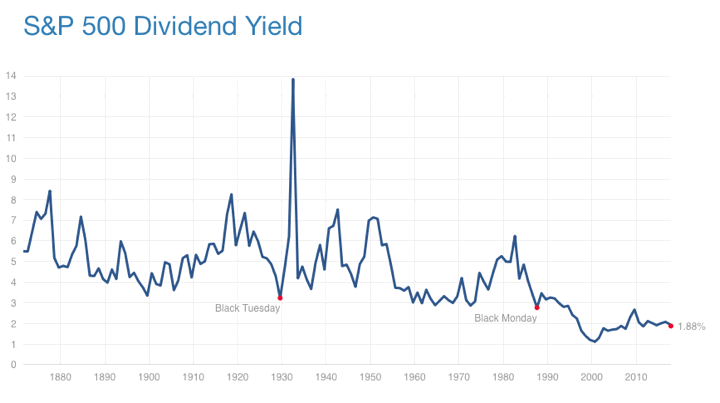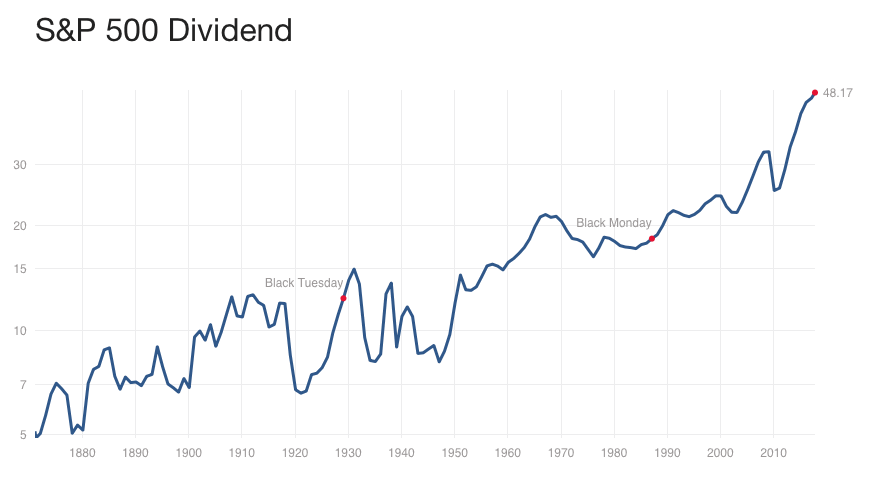
How do you know when you portfolio is enough to retire on? You have to figure out a withdrawal strategy first. This is a tricky question and full of worries about running out of money. You could take out a fixed amount (i.e. $50,000 a year). You could take out a fixed percentage (i.e. 4% a year). You can adjust for inflation. You can implement upper or lower guardrails.
Personally, I appreciate the behavioral reasons why living off income while keeping your ownership stake is desirable. The analogy I fall back on is owning a rental property. If you are reliably getting rent checks that increase with inflation, you can sit back calmly and ignore what the house might sell for on the open market.
I’ve also come to feel that dividend yield can be a quick-and-dirty way to adjust your withdrawal rate for valuation. For example, if the price of S&P 500 index goes up while the dividend payout stays the same, then wouldn’t it be prudent to simply spend the same amount? Check out the historical S&P 500 dividend yield via Multpl. Focus the last 20 years – the yield was highest in the 2008 crash and lowest in the 2000 tech bubble.

Now check out the absolute dividend amount (inflation-adjusted), also via Multpl:

Note that if you only buy “high-yield” stocks and “high-yield” bonds, that actually increases the chance that those yields will drop sooner or later. I am trying to reach some sort of balance where I spend the income on a “total return” portfolio.
Even the venerable Jack Bogle advocated something similar in his early books in investing. He suggested owning the Vanguard Value Index fund and spending only the dividends as way to fund retirement.
One simple way to see how much income (dividends and interest) your portfolio is generating is to take the “TTM Yield” or “12 Mo. Yield” from Morningstar (linked below). Trailing 12 Month Yield is the sum of a fund’s total trailing 12-month interest and dividend payments divided by the last month’s ending share price (NAV) plus any capital gains distributed over the same period. SEC yield is another alternative, but I like TTM because it is based on actual distributions (SEC vs. TTM yield article).
Below is a very close approximation of my most recent portfolio update. My current target asset allocation is 66% stocks and 34% bonds, and intend that to be my permanent allocation upon early retirement.
| Asset Class / Fund | % of Portfolio | Trailing 12-Month Yield (Taken 10/23/17) | Yield Contribution |
| US Total Stock Vanguard Total Stock Market Fund (VTI, VTSAX) |
25% | 1.85% | 0.46% |
| US Small Value Vanguard Small-Cap Value ETF (VBR) |
5% | 1.81% | 0.09% |
| International Total Stock Vanguard Total International Stock Market Fund (VXUS, VTIAX) |
25% | 2.57% | 0.64% |
| Emerging Markets Vanguard Emerging Markets ETF (VWO) |
5% | 2.34% | 0.12% |
| US Real Estate Vanguard REIT Index Fund (VNQ, VGSLX) |
6% | 3.90% | 0.23% |
| Intermediate-Term High Quality Bonds Vanguard Intermediate-Term Tax-Exempt Fund (VWIUX) |
17% | 2.81% | 0.48% |
| Inflation-Linked Treasury Bonds Vanguard Inflation-Protected Securities Fund (VAIPX) |
17% | 2.99% | 0.51% |
| Totals | 100% | 2.53% |
If I had a $1,000,000 portfolio balance today, a 2.5% yield means that it would have generated $25,000 in interest and dividends over the last 12 months. (The muni bond interest in my portfolio is exempt from federal income taxes.) Some comparison numbers (taken 10/23/2017):
- Vanguard LifeStrategy Moderate Growth Fund (VSMGX) is a low-cost, passive 60/40 fund that has a trailing 12-month yield of 2.06%.
- Vanguard Wellington Fund is a low-cost active 65/35 fund that has a trailing 12-month yield of 2.48%.
These income yield numbers are significantly lower than the 4% withdrawal rate often quoted for 65-year-old retirees with 30-year spending horizons, and is even lower than the 3% withdrawal rate that I usually use as a rough benchmark. If I use 3%, my theoretical income would cover my projected annual expenses. If I used the actual numbers above, I am close but still short. Most people won’t want to use this number because it is a very small number. However, I like it for the following reasons:
- Tracking dividends and interest income is less volatile and stressful than tracking market prices.
- Dividend yields adjust roughly for stock market valuations (if prices are high, dividend yield is probably down).
- Bond yields adjust roughly for interest rates (low interest rates now, probably low bond returns in future).
- With 2/3rds of my portfolio in stocks, I have confidence that over time the income will increase with inflation.
I will admit that planning on spending only 2% is most likely too conservative. Consider that if all your portfolio did was keep up with inflation each year (0% real returns), you could still spend 2% a year for 50 years. But as an aspiring early retiree with hopefully 40+ years ahead of me, I like that this method adapts to the volatility of stock returns and the associated sequence of returns risk.
 The Best Credit Card Bonus Offers – 2025
The Best Credit Card Bonus Offers – 2025 Big List of Free Stocks from Brokerage Apps
Big List of Free Stocks from Brokerage Apps Best Interest Rates on Cash - 2025
Best Interest Rates on Cash - 2025 Free Credit Scores x 3 + Free Credit Monitoring
Free Credit Scores x 3 + Free Credit Monitoring Best No Fee 0% APR Balance Transfer Offers
Best No Fee 0% APR Balance Transfer Offers Little-Known Cellular Data Plans That Can Save Big Money
Little-Known Cellular Data Plans That Can Save Big Money How To Haggle Your Cable or Direct TV Bill
How To Haggle Your Cable or Direct TV Bill Big List of Free Consumer Data Reports (Credit, Rent, Work)
Big List of Free Consumer Data Reports (Credit, Rent, Work)
but u dont address possible dividend cuts?
Dividend cuts are certainly possible, as are market price drops. This is simply my replacement model for “okay let’s just use 4% or 3%” to decide if I know if I have enough. 2.5% variable leaves more wiggle room, don’t you think?
In terms of real world withdrawals, I’ll just have to adjust. If the income drops a little, I can adjust my spending. If it drops a huge amount, maybe I’ll take out more than the dividend/interest that year. If the income goes up a lot, I’ll try to reinvest what I don’t spend. It’s basically the same as other withdrawal strategies in that regard.
I can tell you firsthand that a successful early retirement is more dependent on your ability to control expenses then generate income. In today’s environment and the last 7 years of zero percent interest rates it easier to not spend a dollar then to be forced up the risk curve to make a dollar. The second element is to come as close as possible to totally eliminating fixed overhead costs and have complete control over your variable costs. Third, if it is not economically viable to live early or standard retirement in the US have no hesitation about leaving because there are safer, less expensive, higher quality of living countries with affordable health care, favorable exchange rates, retirement or long term visas and inexpensive housing costs. And finally, if its not too late for you…..never have children.
Good thoughts. Too late for me on the kid front! 😉
My husband and I are very interested in possibly moving out of the country when we “retire”. We are in our early 40s, no children, 100% debt free (we own our house), a net worth of ~$500k & I will have a pension when I turn 65. We’re thinking about an early retirement when we reach 50. What are your thoughts on living abroad? We would love to be somewhere warm year round. Thanks!
I know children cost a lot of money and then later there’s grandchildren and sometimes the kids get divorced and you want to help them. It’s the part of life that has enriched me beyond any monetary amount, but there’s problems too. I still have a happy life with enough money. And I have kids and grandkids.
BTW. What countries do you recommend?
There are lots of different options depending on your personal preferences and priorities. Many Americans are drawn to Mexico, Cost Rica, Chile, Panama etc. I’ve personally never been drawn to that particular area though cost of living and healthcare costs are advantages that they offer.
Many European countries have retirement and long stay Visas and very reasonable requirements for entry. Spain and Portugal were top destinations because of their relatively low cost of living and France and Italy have well established retirement/long stay visa programs. My tendency is to avoid countries where I’m not getting a premium on my $US. Canada which has a lot of appeal has no long stay Visa program though there is some type of family/grandparent visa if you have relatives there.
Which takes me to Asia and India which are and have been my top choices. Thailand has a retirement Visa which is easy to get. Laos is a great country for a laid back affordable lifestyle. Singapore is very desirable but expensive and Malaysia has a very attractive expat retirement Visa program and many people have found Kuala Lumpur and surrounding areas an enjoyable places to live. China especially in Yunnan Province, Dali, Lijiang, Shangrila or Hainan and Xiamen, among other places are not as much of a stretch as you might think. Very safe, low cost of living, unbelievably affordable good quality healthcare, $US5 tui na one hour massages and 10 year visas are now available. Banking and transfer of funds either through Bank of China in NY or HSBC make moving money into the country seamless and easy.
I’ve been to India many times and love the country and people. I recently went to see a top Orthopedic Surgeon there. It costs 177 Rupees or $US2.50 that’s for two visits. You can literally live in a 4 star beach side resort all inclusive for less then the average cost of living in the US. For the most part you feel very safe, food is great and depending on the area you choose (I tend to like most places in Kerala though the north has much to offer as well ) your environment can range from pristine to the chaos of their bigger cities. If I were to make a recommendation I’d say start in Cochin and work your way south.
Finally, New Zealand which is in flux right now with their new Labour Government had/has a long stay Visa that requires some significant monetary deposits into the country (not investments just deposits). New Zealand is amazing, cost of living is reasonable, mass transit is excellent, healthcare costs used to be about $NZ60 to see a general practitioner.
Kind of a long answer…..but as Jonthan’s blog makes obvious….thinking out of the box and trying new things often leads to unexpected benefits and positive outcomes.
Gary – thank you! That’s a great run down of ideas and places – I will start my research now.
Thanks Gary…very informative. We are thinking about Latin America or Spain, but maybe only for 6 months of the year. I have been working on my Spanish for 30 years (brain freeze?) and seemed to have plateaued at the intermediate level but I can still make myself understood.
I also like the idea of being able to just eventually take dividends and interest for living expenses and ideally leaving principal alone. I’ve noticed in recent years, even in this low rate environment, the annual income on my portfolio is becoming a tidy sum — not enough yet to cover all our expenses but getting there. In my way of thinking, this will be a modification of the “bucket approach” to retirement asset allocation in which I’m automatically replenishing the cash bucket on an ongoing basis with each distribution and interest payment.
The only quirk I face is that my wife’s old 403-B plan is in tax sheltered annuities, which just reflect dividends and capital gains in increased unit values rather than making actual distributions. The money is with TIAA-CREF, which has a very “Vanguard like” approach, so I’m okay leaving it there. I figure when the time comes, we can just make withdrawals to mimic a dividend payment, perhaps using the yield on the S&P 500 as a guide.
Jonathan,
Are you invested in Wellington Fund? and how come?
hi Jonathan,
did you remove my comment about Vanguard Wellington?
sorry,I see it now
I think you’re being way too conservative here. Thats ok, if you’ve taken into consideration the tradeoff on years worked to save more with a say 2.5% withdrawal rate. The creator of the 4% rule was on Reddit recently and he said its more like 4.5% number now but perhaps as low as 4% for longer retirements. The other piece to consider is flexibility in the withdrawal rate based on previous years financial performance. Many papers written on this and you’ll notice the rate doesnt have to move much to lower your risk substantially.
Your strategy seems more like “I never want to dip into my funds and I want to die with lots of money to pass on”, which is fine too. However, I have a good friend with the same risk aversion who retired last year (at 50) and he’s now regretting not doing it 7 years earlier. Hindsight is 20/20 but I feel its worth the risk to try earlier and go back to work later for a few years if it doesnt pan out. Easier said than done I bet….
Just out… THE cheapest ETFs..
“Franklin Templeton Investments is aggressively expanding its lineup of exchange traded funds, launching 16 new country-specific, passive index-based strategies….
The developed country-specific ETFs each come with a 0.09% expense while the emerging country-specific ETFs, which include FLBR, FLCH, FLMX and FLTW, each have a 0.19% expense ratio. These Franklin Templeton country-specific ETFs are among the cheapest options available for targeting their respective markets.”
https://www.etftrends.com/franklin-templeton-debuts-16-passive-etfs-new-international-suite/
https://blogs.wsj.com/moneybeat/2017/10/30/franklin-templeton-undercuts-blackrock-on-single-country-stock-etfs/